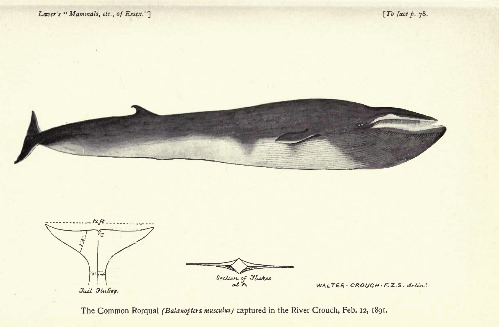The Burnham Whales
|
At least four Whales made their way into the Crouch three of which became beached in the late 1800's and caused much excitement.
The first was in November 1883 on the south side of the Crouch at Foulness by a local fisherman called Page. The 35 feet long whale was exhibited at Southend on Sea drawing large crowds. Lord Mildmay as Lord of the Manor took legal action against Mr Page at which point the ownership reverted to Lord Mildmay but Mr Page was allowed to keep the profits from the ;exhibition. Professor Flower identified the carcass as a Rudolphi's Rorqual Whale Then on 5 September 1885 again at Creeksea another whale was stranded. This time the whale was a Risso's Grampus. This whale is not normally found as far north and naturalists were upset to find that the whale was quickly boiled down by local Creeksea men although it's bones were rescued and taken to the British Museum. The second and most celebrated took place on 12 February 1891 near the mouth of the River at Holiwell Point. The whale appeared to have entered the Crouch on a flood tide and become stranded in shallow water. The whale was later identified as a female large Common Rorqual Whale . It was found by Burnham dredger man Isaac Courtman. Within an hour over 30 men were at the scene securing the whale with ropes . The men were led by Essex Police Inspector Rome who was seconded to the Burnham Oyster Company. Inspector Rome and John Auger also from the Burnham Oyster Company shot the whale a number of times until it died. The smacks Plover and Teazer and the steam vessel Jumbo towed the whale into Burnham The whale was seized by Mr Finch the Customs Officer and put up for auction and bought for £17 10 shillings by Mr J S Prior of Southminster and Mr Henry Cook and John Hawkins of Burnham. The whale was put on display on the following Friday and Saturday when 1,200 people paid to be allowed to see the carcass. Such was the interest that the railway laid on special trains to cope with the visitors. After a few days on display the rotting flesh smelt so bad that the flesh was removed and used as manure on land at nearby Southminster. The skeleton was bought by Mr Bunting and Mr A Newman who cleaned the bones and exhibited it to the public. The carcass was later taken to Southend on Sea where it was exhibited for the summer season of 1891. The whale was felt to be remarkable in that part of its skin near its jaws was coloured white. Local naturalist Walter Crouch visited the scene and took measurements of the whale and made a sketch of the whale. On 7 April 1891 another whale was sighted in the River Crouch by sailors on the vessel Jumbo having been heard blowing in the River during the night. The whale was stranded on the sandbanks in the estuary but was able to make its way to sea when the tide came in before it could be captured. Essex Naturalist E A Fitch investigated the reports. He believed the whale to be a Common Rorqual but was unable to be certain. |




